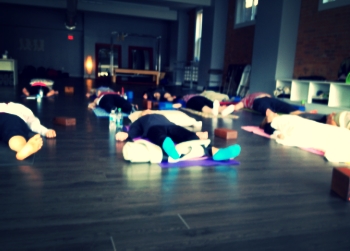Yoga and Joint Mobility
 The amazing thing about the body's joints is that they function so well for most that we don't truly notice them until there is a problem. In many forms of yoga the physical realm of benefit, is so focused on increasing strength and flexibility, that the idea of mobility is seen more of a side benefit to the practice than the main event. However, for anyone who has joint restriction due to an injury, a health condition (like arthritis) or a side effect of aging, the loss of joint mobility and range can be a major interruption to life.
The amazing thing about the body's joints is that they function so well for most that we don't truly notice them until there is a problem. In many forms of yoga the physical realm of benefit, is so focused on increasing strength and flexibility, that the idea of mobility is seen more of a side benefit to the practice than the main event. However, for anyone who has joint restriction due to an injury, a health condition (like arthritis) or a side effect of aging, the loss of joint mobility and range can be a major interruption to life.
Recently, I have been writing about my own current state dealing with chronic pain and joint issues. Hearing from many readers and yogis who can relate to the emotional and physical struggle of such similar challenges has been powerful. What we haven't touched upon are the more practical actions of self-care for joint mobility. Here are some of my strategies.
Keep it Real, Keep it Safe
One of the first things you will notice with any joint discomfort is that pushing through it is not an option. If a joint doesn't open or close you can't force it without risking serious injury. All the fun tricks and acrobatic yoga postures that we may aspire to and deem "advanced" may no longer be realistic goals. In other words, allow your practice to be what it is and if you have a restriction that won't change no matter how much you "stretch and strengthen" enjoy the freedom you do have. The beautiful thing about yoga is that is can be both a potent physical challenge, deeply restorative or both at the same time.
Keep it real and keep it safe.
Enjoy what you are able to do. If you feel frustrated by the loss of physical comfort or range of motion at times, that is totally understandable. Overall, try not to let those feelings hold you back from doing as much as you are able to do in your new physical reality.
Move it or Lose it in the Morning
Pain caused by joint restriction is a strange thing. The instinct to avoid pain is strong and if you are suffering upon movement (especially after long periods of rest or a night of sleep) it feels natural to want to avoid moving further. However, every doctor and expert I know who works with arthritis or joint mobility issues recommends infusing as much movement as possible into the day. If morning tends to be the worst time for you, getting sufficient rest followed by a gentle joint mobility routine could yield huge results. Who wouldn't want to start the day of with less discomfort and a brighter outlook?
Home Practice or Studio Practice?
When it comes to practice specific to joint mobility, the yoga world is sadly lacking in material directed towards this topic (it has become a personal mission of mine to offer more classes, workshops and yoga audios for people who need it). However, yoga offers so much potential for anyoneone who suffers physically, emotionally and even spiritually because of pain and joint restriction. There are benefits to yoga whatever way you enjoy it.
Studio Class Benefits
In a studio class, you allow someone else to guide you through a practice and do so in a community that is interested in greater health, well-being and peace of mind. Making friends with fellow students is a happy side effect of practicing in public classes. There are some things you will want to consider when you attend studio classes:
1. Do your research on the teacher and the studio. If your desired instructor has a background in bodywork, injury rehab or just sounds amazing to you, check out their class. Gold star if they have worked with chronic pain and physical limitation. Knowing the overall mission of the studio or yoga school is also important. Look for places that seek to improve the quality of life for people in the community and go out of their way to make you feel welcome while addressing your needs.
2. Inform your teacher that you need modifications. The most annoying thing about joint restriction is that you will be spotted. While it can be slightly embarrassing at first, approach every new teacher you meet and list off your limitations. Respect the fact that in a public class the teacher is trying to taking care of a lot of people while leading a practice. If you are moving half pace to everyone else in the room or have to modify a good portion of the postures, it is important to try and speak to the instructor about the joint difficultly before the class begins. Even if you have done your best to pick a studio and teacher who seems knowledgeable, we instructors can't read your mind and are not trained to diagnose or treat any health condition (even if your teacher is a health care professional, when they are wearing the "yoga teacher hat" this crosses ethical and often legal lines). It will be a huge favour to both the teacher and to yourself to inform them that some areas of your body hold non-negotiable restriction. The last thing anyone wants is for a well meaning verbal prompt or physical adjustment to cause an injury.
Home Practice Benefits
A home practice offers a wide array of benefit. I wrote a full post about it here. Home practice works with your schedule, there is zero travel time and costs virtually nothing. Should you decide that you want to test drive a home yoga practice here are a few tips to help make it solid.
1. Doing something is better than nothing. I mentioned that the presence of pain can strongly deter you from moving when you feel still or sore, and on a bad day it may not fly to roll out your mat and commit to a full practice. However, doing just fifteen minutes of mobility yoga work is so much better than skipping it all together.
2. Create a Routine. While it may seem like a home practice would be easier than going to a studio (no travel time or set schedule to follow), the distractions of being at home are ample enough for many to prevent presence of mind and body. To help slay the dragons of distraction, book a time with yourself everyday to do your yoga and stick to it. Once getting to your mat is second nature, you will have the fuel of routine (hopefully) backed by a deep love for what you are learning and how it positively influences your life.
The Most Important Advice
Treat your class time like an experiment. It can be daunting to jump into a public class or home practice and find out that you aren't able to do every posture. If I only had one pearl of wisdom to give, it is this:
Don't decide before you begin what you can, or can not do.
Let your mat be the lab and let go of all the attachments, expectations and value judgments you place upon yourself to have a certain physical or spiritual experience. Getting on the mat in the first place is more than half the work. If you showed up today on your mat, you have already earned your own gold star for making the choice to do something in favour of your health and well-being.
And if you need a little more help, on Friday I am releasing a yoga audio/ video combo designed for joint mobility and chronic pain. It is a sequence I have used to keep me moving especially as inflammation has restricted most of the joints in my limbs. This sequence can be used and modified for most people who need some general joint love.
Photo Credit: Yoga at Sunset by Dennis Yang


